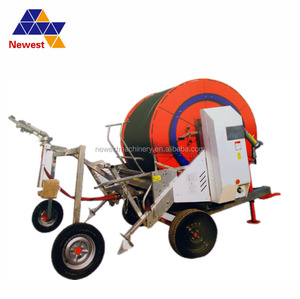(730 products available)






































































































































































































































Small farms usually use small farm irrigation systems to water crops. These systems are cheap, simple, and good for farms that do not grow big harvests. Common irrigation options for small farms include furrow irrigation, drip irrigation, sprinkler irrigation, and rain gardens or rainwater harvesting systems.
Efficiency is crucial in the agriculture sector. It is crucial to improve productivity while cutting down on operating expenses. Small farm irrigation systems allow farmers to water crops efficiently.
Drip irrigation works best for high-value crops. It delivers water directly at the root zone of each plant. It is ideal for areas with limited rainfall. Farmers can also use the system for seed germination and to grow plants in greenhouses. The precise control of water delivery also works well for row crops, fruit trees, vineyards, and vegetable farms.
APeasant farmers with low tech and small scale farming use buckets and gravity fed irrigation systems. They also use simple tubing and drip emitters to irrigate crops. Gravity fed systems have low energy costs and are affordable.
Spray irrigation systems work well in small farms with different types of crops. Sprinklers mimic rainfall and allow water to cover large areas. Farmers use the irrigation system on field crops, lawns, gardens, and landscaping. Sprinklers and pivot systems work well for vegetable farms and fruit orchards. In addition to irrigation, farms can use the system for frost protection, pesticide application, and cooling.
Small farm irrigation systems are useful in arid and semi-arid regions where rainfall is insufficient. They support agriculture in dry landscapes. The irrigation systems also allow farmers to start farming in new places without sufficient water.
Large farms can also use small farm irrigation systems to grow crops on small areas. The systems make it easy to manage irrigation on small portions of land within larger farms. They support specialty farming, such as nurseries, greenhouses, and intensive livestock farming that needs high levels of water management.
There are some things to consider when choosing an irrigation system. Remember that the farm's needs, size, and budget will determine what kind of irrigation system is most suitable.
Farm size and topography:
The farm's size and land shape will have an impact on the irrigation method that should be chosen. Smaller farms that have flat land could use sprinkler irrigation or drip irrigation. Farms that are large and also have diverse areas may need to use more advanced systems like central pivot irrigation.
Crops and water requirements:
Consider the types of crops grown on the farm and their water needs. Some crops may need large quantities of water. Farmers can choose irrigation methods with high volumes. Other crops may require precise watering. Drip irrigation systems that deliver water precisely to each plant can be chosen.
Water source and quality:
Farmers need to consider the amount of water that can be drawn from the water source and its quality. If the water has a lot of impurities, flexible irrigation systems like sprinklers could be used instead of drip irrigation to avoid clogging.
Cost and budget:
Small farm irrigation systems come at different costs depending on the type. A farmer will need to consider the cost of installing the system, the maintenance, and the amount of energy it can use each month.
Land cultivation practices:
The method of farming also has an effect on the irrigation system selected. For instance, farms that use drip irrigation may prefer a drip-line irrigation system because it can reduce water loss and increase efficiency.
Climate and rainfall patterns:
The climate where the farm is located will also affect the irrigation method chosen. In dry areas where rainfall is low, systems that are water-efficient, such as drip irrigation, should be used. On farms that experience a lot of rainfall, simpler systems like surface irrigation may be used.
Q1: What factors should buyers consider when choosing a small farm irrigation system?
A1: Buyers should first consider their farm size. Different systems have varied degrees of suitability for small to large areas. Water source capacity and pressure are also crucial since some systems function optimally at certain pressures. Soil type and crop needs, system costs, ease of installation and maintenance, as well as climate and weather patterns, are other factors to consider.
Q2: Can a small farm irrigation system be scaled up as the farm grows?
A2: Many small farm irrigation systems are designed to be scalable. For instance, farmers can add more drip lines to the drip irrigation system, and they can also increase the number of sprinklers in the sprinkler system. Some farmers also opt to start with smaller center pivot systems and scale up to larger sizes as they become more comfortable with the technology.
Q3: What are some common small irrigation system maintenance practices?
A3: System cleaning is a common practice especially for micro-irrigation tools, since debris and mineral deposits can clog emitters and filters. Users should also check for leaks, drips, or damaged components and promptly repair any damages. Users should monitor pressure and flow and ensure that the system is functioning properly and delivering the required water amount. Irrigation systems should be winterized or flushed when not in use to prevent freezing and damage.
Q4: Are there any new small farm irrigation technologies?
A4: Yes, many technologies are being used to improve irrigation efficiency. These include smart irrigation controllers that adjust watering based on weather conditions, sensor-based irrigation that uses soil moisture sensors to automate irrigation, and automated irrigation systems that can be set on timers to provide preset irrigation. These technologies help small farmers efficiently use water resources.